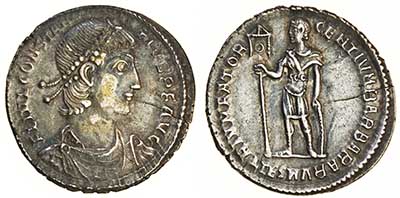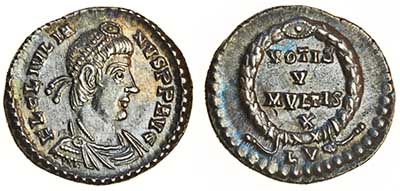The East Harptree Hoard

East Harptree is a small village some 16 miles south-west of Bath and it was the site of the discovery of about 1500 largely mint-condition Roman silver coins all dating from the 4th century which is known as the 'Harptree Hoard'. It was discovered on the land of Mr William Kettlewell of Harptree Court - used as the filming location for Series 3 and 4 ofThe Great British Bake-Off. During the dry summer of 1887 the water supply to the village of East Harptree had run very low and it was decided to search for an additional spring on the Mendip Hills that could be conducted into the mains pipes to supplement the supply. In November of that year, while searching for the source of a spring in Harptree Woods, a labourer called William Currell put his pick into a vessel full of Roman coins. The jar was 6 inches (15cm) below the surface in swampy ground.
The vessel, which was made of pewter or some other white metal, had already been broken into several pieces. The vessel was subsequently restored, as far as possible to its original form by Mr Talbot Ready. The accompanying woodcut gives some idea of its shape. It was about 23.5cms tall, almost 18cms at its diameter and 10cms at the base. Later, the neck of the vessel was discovered by Mrs Kettlewell. It was almost 4cms long with an inside diameter of just over 3cms and showed a trace of originally having had some sort of a handle attached to it.
|
|
It contained 1,496 coins, five ingots of silver and a ring set with an intaglio. The coins covered the period between the reigns of Constantine the Great and Gratian - from 306 until 383 AD. The silver ring is set with a carnelian on which is engraved with the figure of Mars bearing a trophy and spear. The silver ingots are of varying sizes and do not seem to have been adjusted to any regularly graduated weight, although they obviously had some monetary value. They were probably acquired in some business deal by the original owner of the hoard.
Mr Kettlewell subsequently made the hoard available for study at the British Museum and it was written up by John Evans for the Numismatic Chronicle of 1888, pages 22-46. The British Museum was given 25 of the most interesting coins and the remainder were returned to the owner. Mr Kettlewell's son, Colonel Kettlewell, gave the jug and a portion of the hoard to the local church (to be put on display) from where they were subsequently stolen. Many years later the rest of the hoard - nearly 1200 coins - was given to the father of the consignor by Mr Kettlewell's son, and they have remained in their packaging ever since.
John Evans noted, 'The coins when found were to some extent coated in dirt, and with what was probably a little chloride of silver. When carefully washed and brushed their remarkably good condition became apparent and there was none but could be attributed to the emperor under whom they were struck'.
 |
Constantius II (AD 337-361), AR Miliarense, Thessalonika mint.
The coins offered in the auction are as they were when returned from the British Museum in 1887-1888. Many exhibit light deposit, which could easily be removed by a competent conservator, but at the expense of the mint bloom that is apparent on many of the coins. The overall quality is remarkable, and few, if any, are clipped. Large numbers look quite ordinary to the naked eye but when tilted towards the light or examined under magnifi cation, reveal extraordinary quality. All the pieces were coined between the late 330s and mid 370s AD. Below is a list of the emperors represented in the hoard and the number of coins struck under each.
| Constantine the Great | 1 |
| Constans | 4 |
| Constantius II | 340 |
| Decentius | 1 |
| Julianus II | 718 |
| Jovianus | 8 |
| Valentinianus I | 165 |
| Valens | 199 |
| Gratianus | 60 |
In addition, there was a single silique of Magnus Maximus included with the packaged coins - not mentioned by Evans, so probably a stray find added later. The coins came from 11 different mints and in some of these there have been several different workshops or officinae. These are sometimes designated by the letters P, S, T for Prima, Secunda, Tertia etc or by the letters on the field OF I, OF II, OF III. The coins in the Harptree hoard were issued from the following mints:
| Antioch ANT 22 | ANT | 22 |
| Aquileia SMAQ 1 | SMAQ | 1 |
| Arle | Constantina CONST P.CON-P.CONST S.CON-S.CONST T.CON-T.CONST | 27 166 183 177 553 |
| P.CON-P.CONST | CONST | 166 |
| S.CON-S.CONST | CONST | 183 |
| Constantinople |
| 4 |
| Lyons | LVG P.LVG S.LVG | 318 114 142 574 |
| Nicomedia | SMN | 4 |
| Rome | Rome R.P., R.B., R.T., R.Q., etc | 99 |
| Sirmium | SIRM | 6 |
| Siscia | SIS | 1 |
| Thessalonica | TSE TES | 12 |
| Trier | TR., TRPS | 2017 |
| Uncertain |
| 13 |
|
|
There are pieces of at least three different modules in the hoard. The majority by far are of small size and were struck at the nominal rate of 144 to the Roman pound (c 327.436g) which would make the proper weight of each around 2.27g. The coins of larger module and weight belong to an earlier period and were probably struck on the standard of 96 to the pound and full weight would be 3.40g. It can be seen at once that the majority of the coins come from the Gallic mints of Arles and Lyons and Trier in modern Germany, although several were minted much further afield in Antioch, Sirmium, Constantinople, Thessalonica and Rome.
 |
Lot 2875 Julian II (AD 360-363), AR Siliqua, 2.31g, Trier mint.
The largest pieces, medallions, or, as they came to be known, miliarenses, seem to have been intended to represent double the size of the ordinary small pieces and to have been coined at 72 to the pound. There were 15 in the Harptree hoard. It is worth mentioning that a large proportion of these miliarenses have been present in other West Country hoards, notably the Holway hoard (33 miliarenses to 285 small coins or siliquae) and for the most part they were coined in the distant mints and of a later period. As a general rule the miliarenses are in an excellent state of preservation and are thought to have been more treasured by their original owners than the small coins which were in everyday use.
 |
Lot 2877 Julian II (AD 360-363), AR Siliqua, 2.48g, Lugdunum mint.
So when was the Harptree hoard deposited? The clue to this lies not only in the coins that are present in the hoard but also in those that are not there. Evans and subsequent numismatists seems to agree to a date of around 375 AD. There is evidence for continued Roman occupation in the area, including the mining settlements, into the fourth century but not beyond. And this ties neatly into the date of the deposition of the hoard according to Evans.
In total there were some eight settlements and at least two large villas in the area. Less than five miles away the Romans mined lead and silver at Charterhouse and farmed at Chew Park now under Chew Valley Lake. Charterhouse Roman Town was located just to the west of the village of Charterhouse-on-Mendip, Its Latin name may have been Iscalis, but this is more likely to have been nearby Cheddar. Based on inscriptions on a pig of Roman lead - BRIT. EX. ARG. VEB - the Roman name has been reconstructed as Vebriacum.
The settlement grew up around the north-western edge of prehistoric lead and silver mines, which were exploited by the Romans. Mendip lead ore had up to 0.4% silver content, which the Romans used to pay the army. Extraction is thought to have begun around AD 60. At first the lead and silver industries were tightly controlled by the Roman military (in the south-west, by the Second Legion) and there was a small fort adjoining the mines during the 1st century, which was probably little more than a fortified compound for storing lead pigs. Smelting was undertaken on site where industrial workshops have been excavated, and the metal exported along a minor road to the Fosse Way, and probably through a small inland port at nearby Cheddar.
An amphitheatre stood west of the settlement. It is the only one in England to exist at a lead mine and is additional evidence of the importance of Mendip lead to the Romans. It measures 32m x 24.4m and the banks for the seating survive 4.5m above the arena. It was surveyed in 1909 and was probably a place of entertainment for the soldiers at the Roman fort which was established here.
How the hoard came to be there and who buried it (probably some sort of a trader) is an entirely different matter and something that we will never now discover. The Romans were gradually beginning to pull out of Britain by then. But what happened in 375 AD in the Mendips to cause this person to leave in such a hurry - he had time to dig only a fairly shallow hole - burying his valuables in the hope of retrieving them when it was safe to return?
The East Harptree Hoard was offered on the 27th September 2016, London




